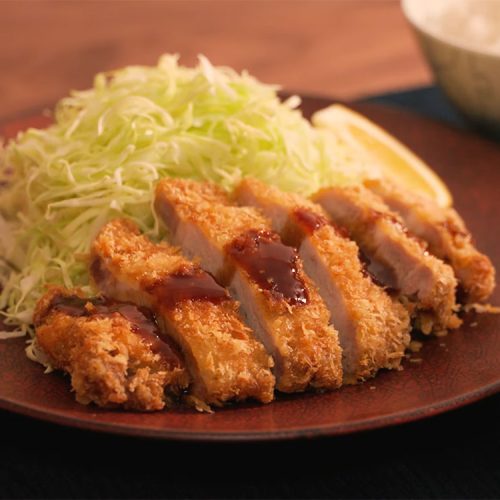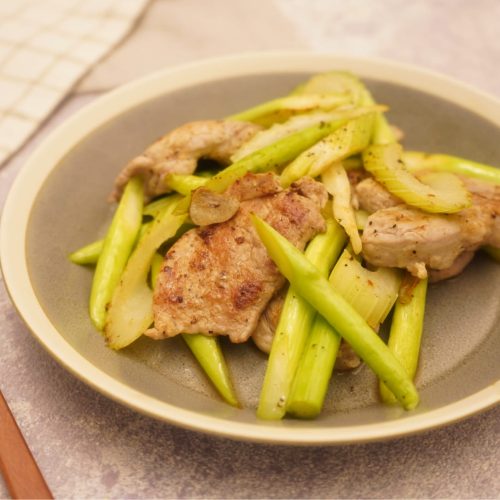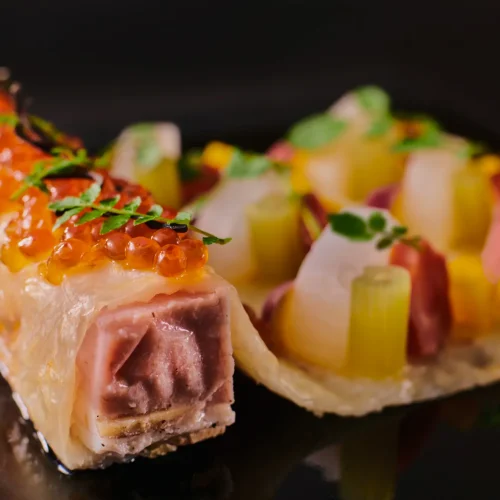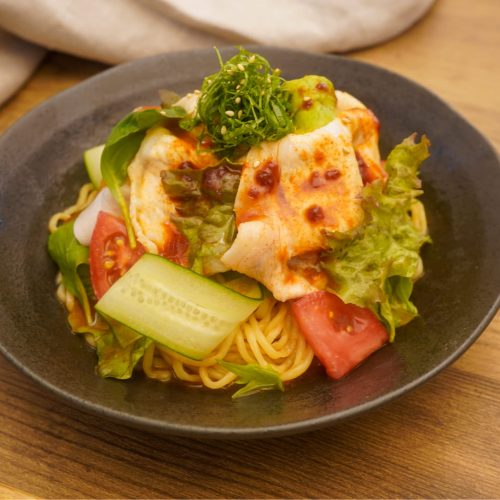Pork Kakuni (Braised pork belly)
Enjoy the tender texture and well-seasoned flavor!
"Movie recipe" introduces a classic pork dish familiar to Japanese diners with video clips. In this third installment, we introduce "Kakuni" using chunks of pork belly.
INGREDIENTS-SERVES 4
- Pork belly chunks 1.2kg
- Green onion 1
- Ginger 1
- Egg As you like
- Sake (Dry white wine) 200cc
- Sugar 3 tablespoon
- Soy sauce 5 tablespoons
- Star anise(As you like) 1
- Mirin 2 tablespoon
* If mirin is not available,
mix 2 tablespoon dry sherry with 2 teaspoon sugar.
PROCEDURE
- Cut the green and white parts of the green onion and slice the ginger into 7-8 thin strips.
- Cut the meat into 4-5 cm cubes.
- Heat oil in a hot frying pan and brown the surface of the meat.
- Place the cooked meat in a deep pan and fill with water to soak the entire meat.
- Sprinkle the green part of the green onion and ginger over the meat, close the lid and cook over medium heat for about 1 1/2 hours.
- Skewer the meat to check for firmness (if it goes through easily, it’s OK), then turn off the heat and lift the meat onto a bat or something similar.
- After reducing the broth by 200 cc along with the scum, return the meat to the pot. Boiled eggs can be added here at the same time.
- Add sake (if not available, dry white wine), sugar, soy sauce, mirin, and Hakkaku to taste.
- Turn the heat back on, bring to a simmer, reduce the heat to low, and simmer gently for 30 minutes.
- After cooking, allow to cool for the flavors to soak in. After cooling, it can be served as is or reheated.
Point
- Some people may not like the aroma of Star anise, but it is said that when used in KAKUNI (Braised pork belly), it adds depth to the flavor and creates a luxurious taste.
It is said that “Pork KAKUNI”, a common Japanese home-style dish, originated from “Dongpo roe” (東坡肉), a Chinese dish introduced to Nagasaki in the Edo period (1603-1868).
“Dongpo roe” is a type of dish called “Hong Xiao Lo” (紅焼肉), which is commonly served throughout China. The dish mainly served in Hangzhou City near Shanghai is called “Dongpo roe”.
Both are made by stewing pork belly with skin on, mainly in a soy sauce base. While “Hong Xiao Lo” is often stewed after grilling the surface of the meat, “Dongpo roe” is stewed after pre-boiling without grilling the surface.
The reason why it is called “Dongpo” only in Hangzhou, even though it is a similar dish, is because it is said to have been created by “Su Dongpo” (蘇東坡), a famous literary figure of the Northern Song Dynasty who was also a famous food connoisseur, during his tenure as an official in Hangzhou.
Su Dongpo, who was instrumental in flood control in the area at the time, was thanked by the local people for his efforts, and when he was presented with pork and Shaoxingjiu (Chinese alcohol), he served it as a stewed dish, which is said to have become “Dongpo roe”.
However, if we look back at the history of this episode, we will find out when Like the “Niku-Jaga” episode, it is said to be an anecdote for publicity, and it cannot be said to be true.
Now, in Japan… although some Chinese restaurants offer authentic “Dongpo roe” or “Hong Xiao Lo”, the majority of Chinese restaurants offer a Japanese version of Kakuni.
The recipe presented here is a more Japanese-style, completely home-style recipe.
The meat is not skin-on like “Dongpo roe”, and sake is used instead of Shaoxingjiu.
Also, instead of starting with pre-boiling, the surface is browned to remove some of the oil and lock in the flavor before cooking.
In this way, it is healthy and time-saving, just like home cooking.
Pork belly is the meat found in the belly of the pig, around the ribs. It is sometimes called ‘sampai’ meat because of the three layers of lean and fatty meat.
KAKUNI is a great way to take advantage of the juiciness of its fatty belly!
Please enjoy it in various ways by referring to the recipes introduced in this issue!
Recommend post
-

EXPERIENCE HOKKAIDO
Hakodate Christmas FatasyHakodate Bay Area, red brick warehouses and giant tree
-

EXPERIENCE HOKKAIDO
Lake Shikotsu, Balancing Tourism and Conservation.-The beauty of the lake seen through a clear kayaking experience-
-

MOVIE RECIPE
Tonkatsu (Pork loin cutlets)"Tonkatsu", a favorite of children in their prime, with a simple sauce recipe that can be made outside of Japan.
-

RECIPE
Garlic butter sauteed pork tenderloin and celery.Seasonal recipes to enjoy
late summer vegetables and
"Yume no Daichi" -

CHEF'S RECIPE
Pork and Hokkaido potato galette
-

RECIPE
Spicy Pork and Summer Vegetable “Mazemen”.Seasonal recipes to enjoy summer vegetables and "Yume no Daichi"